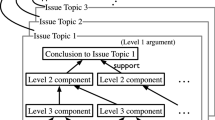Abstract
This paper reports on initial experiments with automatic comma recovery in legal texts. In deciding whether to insert a comma or not, we propose to use the value of the probability of a bigram of two words without a comma and a trigram of the words with the comma. The probability is determined by the language model trained on sentences with commas labeled as separate words. In the training database one sentence corresponds to one line. The thresholds of bigrams and trigrams probability were experimentally determined to achieve the best balance of precision and recall. The advantage of the proposed method is its high precision (95%) at a relatively satisfactory recall (49%). For judges as potential users of an ASR system with an automatic comma insertion function, precision is particularly important.
Access this chapter
Tax calculation will be finalised at checkout
Purchases are for personal use only
Preview
Unable to display preview. Download preview PDF.
Similar content being viewed by others
References
Rusko, M., Juhár, J., Trnka, M., Staš, J., Darjaa, S., et al.: Slovak automatic transcription and dictation system for the judicial domain. In: 5th Language & Technology Conference on Human Language Technologies as a Challenge for Computer Science and Linguistics, pp. 365–369. Fundacja Uniwersytetu Im, A. Miczkiewicza (2011)
Kolář, J., Švec, J., Psutka, J.: Automatic punctuation annotation in Czech broadcast news speech. In: SPECOM 2004, Saint-Petersburg, pp. 319–325 (2004)
Batista, F., Caseiro, D., Mamede, N., Trancoso, I.: Recovering capitalization and punctuation marks for automatic speech recognition: Case study for the Portuguese broadcast news. Speech Communication 50(10), 847–862 (2008)
Huang, J., Zweig, G.: Maximum entropy model for punctuation annotation from speech. In: Proceedings of International Conference on Spoken Language Processing, Denver, pp. 917–920, (2002)
Christensen, H., Gotoh, Y., Renals, S.: Punctuation annotation using statistical prosody models. In: Proc. ISCA Workshop on Prosody in Speech Recognition and Understanding, pp. 35–40 (2001)
Wei, L., Hwee, T.N.: Better punctuation prediction with dynamic conditional random fields. In: Proceedings of the 2010 Conference on Empirical Methods in Natural Language Processing, Cambridge, pp. 177–186 (2010)
Gravano, A., Jansche, M., Bacchiani, M.: Restoring punctuation and capitalization in transcribed speech. In: Proceedings of The International Conference on Acoustics, Speech, and Signal Processing, Dallas, pp. 4741–4744 (2009)
Stolcke, A., Shriberg, E., Bates, R., Ostendorf, M., Hakkani, D., Plauche, M., Tur, G., Lu, Y.: Automatic detection of sentence boundaries and disfluencies based on recognized words. In: Proc. of ICSLP 1998 (1998)
Jakubíček, M., Horák, A.: Punctuation Detection with Full Syntactic Parsing. Research in Computing Science, Special issue: Natural Language Processing and its Applications 46, 335–343 (2010)
Stolcke, A.: SRILM – An Extensible Language Modeling Toolkit. In: Proc. of ICSLP 2002, Denver, pp. 901–904 (2002)
http://www.speech.sri.com/projects/srilm/manpages/ngram-format.5.html
Author information
Authors and Affiliations
Editor information
Editors and Affiliations
Rights and permissions
Copyright information
© 2014 Springer International Publishing Switzerland
About this paper
Cite this paper
Sabo, R., Beňuš, Š. (2014). Detecting Commas in Slovak Legal Texts. In: Sojka, P., Horák, A., Kopeček, I., Pala, K. (eds) Text, Speech and Dialogue. TSD 2014. Lecture Notes in Computer Science(), vol 8655. Springer, Cham. https://doi.org/10.1007/978-3-319-10816-2_8
Download citation
DOI: https://doi.org/10.1007/978-3-319-10816-2_8
Publisher Name: Springer, Cham
Print ISBN: 978-3-319-10815-5
Online ISBN: 978-3-319-10816-2
eBook Packages: Computer ScienceComputer Science (R0)




